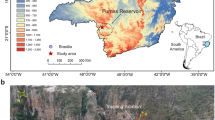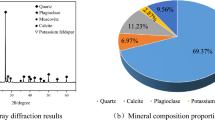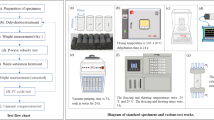Abstract
The behavior of calcareous sand under repeated impact considerably differs from that of silica sand. Notably, calcareous sand is important in engineering projects in the South China Sea, such as pile driving. To understand the behavior of calcareous sand under multiple impacts, the improved split Hopkinson pressure bar (SHPB) system was selected for one-dimensional impact tests of silica and calcareous sand with particle sizes of 0.25–0.50 mm. The sand specimens were impacted 1, 3, 7 and 10 times. The test results reveal that the dynamic apparent stiffness of silica sand is approximately 6–8 times that of calcareous sand. The dynamic apparent modulus values of the two sands increase with an increase in the number of impacts, N. For calcareous sand, the compression index Cc decreases with an increase in N, and silica sand shows the opposite trend. The yield pressure pc of calcareous sand under impact loading is approximately 40% of that of silica sand. With an increase in N, the energy absorption capacity, energy dissipation rate and damage variables of the two sands exhibit a downward trend. In addition, the energy absorption efficiency of calcareous sand is better than that of silica sand. During the process of impact, a large number of sand particles will break, and particle breakage will change the particle size distribution (PSD), thereby significantly affecting the physical and mechanical properties of the corresponding soil. Based on the test results and fractal theory, an evolution model is established to characterize the PSD evolution in the breakage state for uniformly graded calcareous sand. Moreover, a Markov chain model is proposed to describe the PSD evolution of nonuniformly graded specimens. The predicted results of both models show agreement with the experimental values.
























Similar content being viewed by others
Data availability
All data generated or analyzed during this study are included in this published article.
Abbreviations
- l s :
-
Thickness of the sand specimen
- d s :
-
Diameter of the sand specimen
- v :
-
Poisson’s ratio of the sand specimen
- E 0 :
-
Young’s modulus of the bars
- A 0 :
-
Area of the cross section of the specimens
- A s :
-
Area of the cross section of the bars
- c 0 :
-
Elastic wave velocity of the bars with the value of 5200 m/s
- ε i(t), ε r(t), ε t(t):
-
Incident pulse, reflected pulse and transmitted pulse
- σ z(t):
-
Axial stress history
- ε z(t):
-
Axial strain history
- ε z :
-
Value of axial strain history variation
- σ m :
-
Peak stress
- k 1, k 2, k 3, k 4, k 5, a 2, b 2 and c 2 :
-
Fitting parameters
- p c :
-
Yield pressure
- C c :
-
Compression index
- E n :
-
Energy absorption efficiency
- I :
-
Ideality energy absorption ratio
- B t :
-
Total breakage
- B p :
-
Breakage potential
- B r :
-
Relative breakage index
- P(d):
-
Percentage of particles finer than d
- d :
-
Particle diameter
- d 50 :
-
Mean particle diameter
- d max :
-
Maximum particle diameter
- D :
-
Fractal dimension of new grain groups generated from particle breakage
- D u :
-
Ultimate fractal dimension
References
Alba JL, Audibert JM (1999) Pile design in calcareous and carbonaceous granular materials, and historic review. In: Proceedings of the 2nd international conference on engineering for calcareous sediments, vol 1, pp 9–44
Altuhafi FN, Coop MR (2011) Changes to particle characteristics associated with the compression of sands. Géotechnique 61(6):459–471
Charlie WA, Ross CA, Pierce SJ (1990) Split-Hopkinson pressure bar testing of unsaturated sand. Geotech Test J 13(4):192–300. https://doi.org/10.1520/GTJ10172J
Coop MR, Sorensen KK, Freitas TB et al (2004) Particle breakage during shearing of a carbonate sand. Géotechnique 54(3):157–163
Davies ED, Hunter SC (1963) The dcynamic compression testing of solids by the method of the split Hopkinson pressure bar. J Mech Phys Solids 11(3):155–179. https://doi.org/10.1016/0022-5096(63)90050-4
Einav I (2007) Breakage mechanics-part I: theory. J Mech Phys Solids 55:1274–1297. https://doi.org/10.1016/j.jmps.2006.11.003
Fu Z, Chen S, Peng C (2014) Modeling cyclic behavior of rockfill materials in a framework of generalized plasticity. Int J Geomech 14(2):191–204. https://doi.org/10.1061/(ASCE)GM.1943-5622.0000302
Hagerty MM, Hite DR, Ullrich CR, Hagerty DJ (1993) One-dimensional high-pressure compression of granular material. J Geotech Eng 119(1):1–18. https://doi.org/10.1061/(ASCE)0733-9410(1993)119:1(1)
Hardin BO (1985) Crushing of soil particles. J Geotech Eng 111(10):1177–1192. https://doi.org/10.1061/(ASCE)0733-9410(1985)111:10(1177)
Indraratna B, Ionescu D, Christie HD (1998) Shear behavior of railway ballast based on large-scale tri-axial tests. J Geotech Geoenviron Eng 124(5):439–449. https://doi.org/10.1061/(ASCE)1090-0241(1998)124:5(439)
Kadhane SH, Warhatkar HN (2017) Design and development of an integrated compressive-tensile polym-eric split Hopkinson pressure bar setup. Procedia Eng 173:702–709. https://doi.org/10.1016/j.proeng.2016.12.156
Kokusho T, Hara T, Hiraoka R (2004) Undrained shear strength of granular soils with different particle gradations. J Geotech Geoenviron Eng 130(6):621–629. https://doi.org/10.1061/(ASCE)1090-0241(2004)130:6(621)
Ladd RS (1978) Preparing test specimens using undercompaction. Geotech Test J 1(1):16–23
Luo H, Cooper WL, Lu H (2014) Effects of particle size and moisture on the compressive behavior of dense Eglin s-and under confinement at high strain rates. Int J Impact Eng 65:40–55. https://doi.org/10.1016/j.ijimpeng.2013.11.001
Lv Y, Li X, Fan C, Su Y (2021) Effects of internal pores on the mechanical properties of marine calcareous sand particles. Acta Geotech. https://doi.org/10.1007/s11440-021-01223-8
Lv Y, Li F, Liu Y, Fan P, Wang M (2017) Comparative study of coral sand and silica sand in creep under general stress states. Can Geotech J 54(11):1601–1611. https://doi.org/10.1139/cgj-2016-0295
Lv Y, Liu J, Xiong Z (2019) One-dimensional dynamic compressive behavior of dry calcareous sand at high strain rates. J Rock Mech Geotech Eng 011(001):192–201. https://doi.org/10.1016/j.jrmge.2018.04.013
Lv Y, Liu J, Zuo D (2019) Moisture effects on the undrained dynamic behavior of calcareous sand at high strain rates. Geotech Test J 42(3):25–746. https://doi.org/10.1520/GTJ20170412
Lv Y, Wang Y, Zuo D (2019) Effects of particle size on dynamic constitutive relation and energy absorption of calcareous sand. Powder Technol 356:21–30. https://doi.org/10.1016/j.powtec.2019.07.088
Ma L, Li Z, Wang M, Wei H, Fan P (2019) Effects of size and loading rate on the mechanical properties of single coral particles. Powder Technol 342:961–971. https://doi.org/10.1016/j.powtec.2018.10.037
Milts J, Gruenbaum G (1981) Evaluation of cushioning properties of plastic foams compressive measurements. Polym Eng Sci 21(15):1010–1014. https://doi.org/10.1002/pen.760211505
Ouyang H, Dai G, Qin W, Zhang C, Gong W (2021) Dynamic behaviors of calcareous sand under repeated one-dimensional impacts. Soil Dyn Earthq Eng. https://doi.org/10.1016/j.soildyn.2021.106891
Ozkan G, Ortoleva P (2000) Evolution of the gouge particle size distribution: a Markov model. Pure Appl geophys 157:449–468. https://doi.org/10.1007/s000240050008
Russell AR, Khalili N (2004) A bounding surface plasticity model for sands exhibiting particle crushing. Can Geotech J 41(6):1179–1192. https://doi.org/10.1139/t04-065
Sadrekarimi A, Olson SM (2010) Particle damage observed in ring shear tests on sands. Can Geotech J 47(5):497–515. https://doi.org/10.1139/T09-117
Song B, Chen W, Lu V (2009) Impact compressive response of dry sand. Mech Mater 41(6):777–785. https://doi.org/10.1016/j.mechmat.2009.01.003
Song Z, Cheng Y, Tian X, Wang J, Yang T (2020) Mechanical properties of limestone from Maixi tunnel under hydro-mechanical coupling. Arab J Geosci. https://doi.org/10.1007/s12517-020-05373-z
Tong C, Zhang K, Zhang S, Sheng D (2019) A stochastic particle breakage model for granular soils subjected to one-dimensional compression with emphasis on the evolution of coordination number. Comput Geotech 112:72–80
Tyler SW, Wheatcraft SW (1992) Fractal scaling of soil particle-size distributions: analysis and limitations. Soil Sci Soc Am J 56(2):362–369. https://doi.org/10.2136/sssaj1992.03615995005600020005x
Wang X, Jiao Y, Wang R, Hu M, Meng Q, Tan F (2011) Engineering characteristics of the calcareous sand in Nansha Islands, South China Sea. Eng Geol 120(1–4):40–47. https://doi.org/10.1016/j.enggeo.2011.03.011
Wang G, Zha J (2020) Particle breakage evolution during cyclic triaxial shearing of a carbonate sand. Soil Dyn Earthq Eng. https://doi.org/10.1016/j.soildyn.2020.106326
Weibull W, Stockholm S (1951) A statistical distribution function of wide applicability. J Appl Mech 18(3):293–297. https://doi.org/10.1115/1.4010337
Wu Y, Li N, Wang X et al (2020) Experimental investigation on mechanical behavior and particle crushing of calcareous sand retrieved from South China Sea. Eng Geol. https://doi.org/10.1016/j.enggeo.2020.105932
Wu W, Li H, Zhao J (2015) Dynamic responses of non-welded and welded rock fractures and implications for P-wave attenuation in a rock mass. Int J Rock Mech Min 77:174–181. https://doi.org/10.1016/j.ijrmms.2015.03.035
Xia K, Yao W (2015) Dynamic rock tests using split Hopkinson (Kolsky) bar system—a review. J Rock Mech Geotech Eng 7(1):27–59. https://doi.org/10.1016/j.jrmge.2014.07.008
Xiao Y, Liu H, Chen Y et al (2014) Strength and deformation of rockfill material based on large-scale triaxial compression tests. II: influence of particle breakage. J Geotech Geoenviron Eng 140(12):04014071. https://doi.org/10.1061/(ASCE)GT.1943-5606.0001177
Xiao Y, Liu H, Xiao P et al (2016) Fractal crushing of carbonate sands under impact loading. Geotech Lett 6(3):199–204. https://doi.org/10.1680/jgele.16.00056
Xiao Y, Yuan Z, Chu J, Liu H, Huang J, Luo S, Lin J (2019) Particle breakage and energy dissipation of carbonate sands under quasi-static and dynamic compression. Acta Geotech 14(6):1741–1755. https://doi.org/10.1007/s11440-019-00790-1
Yamamuro JA, Bopp PA, Lade PV (1996) One-dimensional compression of sands at high pressure. J Geotech Eng 122(2):147–154. https://doi.org/10.1061/(ASCE)0733-9410(1996)122:2(147)
Yu F (2018) Particle breakage in triaxial shear of a coral sand. Soils Found 58(4):866–880
Zhang S, Tong C, Li X, Sheng D (2015) A new method for studying the evolution of particle breakage. Géotechnique 65(11):911–922
Zhu Q, Li D, Han Z et al (2021) Failure characteristics of brittle rock containing two rectangular holes under uniaxial compression and coupled static-dynamic loads. Acta Geotech. https://doi.org/10.1007/s11440-021-01196-8
Acknowledgements
This work was supported by the National Natural Science Foundation of China (51878160, 52078128). The authors wish to express their sincere thanks to the people concerned.
Author information
Authors and Affiliations
Corresponding author
Ethics declarations
Conflict of interest
The authors declare that they have no known competing financial interests or personal relationships that could have appeared to influence the work reported in this paper.
Additional information
Publisher's Note
Springer Nature remains neutral with regard to jurisdictional claims in published maps and institutional affiliations.
Rights and permissions
About this article
Cite this article
OuYang, H., Dai, G., Qin, W. et al. Experimental study on the mechanical behaviors and particle breakage characteristics of calcareous sand from South China Sea under repeated one-dimensional impacts. Acta Geotech. 17, 3927–3946 (2022). https://doi.org/10.1007/s11440-022-01463-2
Received:
Accepted:
Published:
Issue Date:
DOI: https://doi.org/10.1007/s11440-022-01463-2




